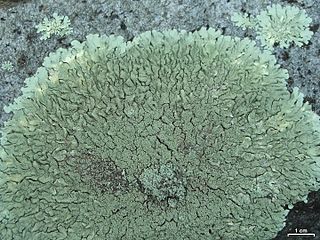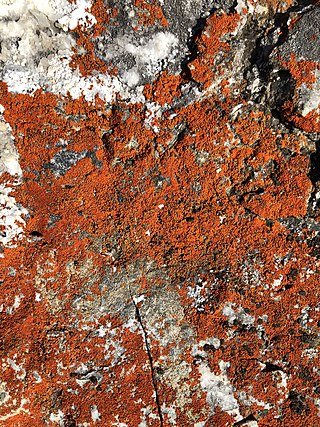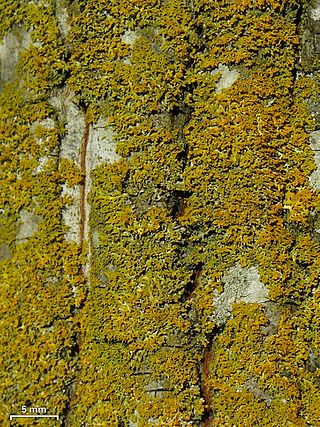
Cetraria is a genus of fruticose lichens that associate with green algae as photobionts. Most species are found at high latitudes, occurring on sand or heath, and are characterised by their "strap-like" form with spiny lobe edges. The lobes can range from narrow and linear to broader and flattened, often forming loose or densely packed cushions. Their distinctive spiny margins serve both a defensive role and aid in vegetative reproduction through fragmentation. The genus was created by Erik Acharius in 1803 and belongs to the large family Parmeliaceae. While originally a species-rich genus, taxonomic revisions since the 1960s have split many species into new genera, though the exact circumscription remains debated among lichenologists.

The Teloschistaceae are a large family of mostly lichen-forming fungi belonging to the class Lecanoromycetes in the division Ascomycota. The family has a cosmopolitan distribution, although its members occur predominantly in temperate regions. Most members are lichens that either live on rock or on bark, but about 40 species are lichenicolous – meaning they are non-lichenised fungi that live on other lichens. Many members of the Teloschistaceae are readily identifiable by their vibrant orange to yellow hue, a result of their frequent anthraquinone content. The presence of these anthraquinone pigments, which confer protection from ultraviolet light, enabled this group to expand from shaded forest habitats to harsher environmental conditions of sunny and arid ecosystems during the Late Cretaceous.

Melanohalea is a genus of foliose lichens in the family Parmeliaceae. It contains 30 mostly Northern Hemisphere species that grow on bark or on wood. The genus is characterised by the presence of pseudocyphellae, usually on warts or on the tips of isidia, a non-pored epicortex and a medulla containing depsidones or lacking secondary metabolites. Melanohalea was circumscribed in 2004 as a segregate of the morphologically similar genus Melanelia, which was created in 1978 for certain brown Parmelia species. The methods used to estimate the evolutionary history of Melanohalea suggest that its diversification primarily occurred during the Miocene and Pliocene epochs.

Xanthoparmelia is a genus of foliose lichens in the family Parmeliaceae. This genus of lichen is commonly found in the United States, South America, southern Africa, Europe, Australia, and New Zealand.

Gyalolechia is a genus of lichen-forming fungi belonging to the family Teloschistaceae. It contains 18 species of crustose lichens.

Igneoplaca is a genus in the subfamily Xanthorioideae of the family Teloschistaceae. It contains a single species, the crustose lichen Igneoplaca ignea.

Usnocetraria is a small genus of lichen-forming fungi in the family Parmeliaceae. It contains two species of corticolous (bark-dwelling), foliose lichens.
Huneckia is a genus of crustose lichens in the subfamily Caloplacoideae of the family Teloschistaceae. It has four species.

Gowardia nigricans, commonly known as the gray hair lichen or gray witch's hair, is a species of fruticose lichen in the family Parmeliaceae.

Wetmoreana is a genus of lichen-forming fungi in the family Teloschistaceae. It comprises 15 formally described species, one subspecies, and three undescribed species of crustose or squamulose that are predominantly saxicolous (rock-dwelling). The genus is characterized by its distinct lobes, orange zeorine apothecia when present, and the frequent occurrence of asexual propagules such as schizidia, isidia, or soredia. A key diagnostic feature is the presence of calcium oxalate crystals in the thallus medulla of many species.

Erichansenia is a genus of lichen-forming fungi in the family Teloschistaceae. It has three species of saxicolous (rock-dwelling), crustose lichens.
Marchantiana is a genus of lichen-forming fungi in the family Teloschistaceae. It contains seven species of corticolous (bark-dwelling), crustose lichens that occur in the Southern Hemisphere.
Upretia is a genus of lichen-forming fungi in the family Teloschistaceae. It has three species of saxicolous (rock-dwelling), crustose lichens. Upretia is characterised by its small ascospores and narrow, rod-shaped conidia. The distribution of the genus ranges from mid-altitude rocky terrains in India to both arid and higher altitudinal environments in China.
Dufourea angustata is a species of saxicolous (rock-dwelling), crustose lichen in the family Teloschistaceae. It is widely distributed across Australia.
Elixjohnia jackelixii is a species of saxicolous (rock-dwelling), crustose lichen in the family Teloschistaceae. It is found in Australia and New Zealand. The lichen is characterised by its unique multilayered appearance with outer sterile rings that are brownish or greenish-yellow and inner areoles that are whitish, yellowish, or greyish, often cracked to reveal the medulla underneath. Its fruiting bodies, or apothecia, are typically attached directly to the thallus and vary in colour and shape.

Gallowayella weberi is a species of corticolous and saxicolous, foliose lichen in the family Teloschistaceae. Found in the eastern United States, it is a small lichen with a smooth yellow to orange upper surface and a contrasting white lower surface.

Xanthomendoza oregana is a species of corticolous (bark-dwelling), foliose lichen in the family Teloschistaceae. It forms an orange to bright-yellow thallus with ascending lobes that gives it the overall appearance of a tuft. The lichen occurs in western and northern Europe and western North America.

Gallowayella borealis is a species of saxicolous and muscicolous, lichen in the family Teloschistaceae. The lichen is characterized by a foliose (leafy) thallus that forms small, cushion-like clusters, with lobes that are often convex and have a distinctive orange colour with a reddish tint, occasionally covered in pruina. It reproduces vegetatively through abundant soralia producing rounded, granule-like soredia. Chemically, it contains high levels of parietin among other lichen products. Gallowayella borealis thrives on both horizontal and vertical rock surfaces, often enriched by guano, and is particularly abundant in continental Antarctica, co-existing with Polycauliona candelaria near penguin rookeries. It has a bipolar distribution, found in the Arctic and boreal forests of the Northern Hemisphere as well as in ice-free zones of continental Antarctica.
Elenkiniana is a genus of lichen-forming fungi in the family Teloschistaceae. It has three species, all of which occur in Eurasia.

Usnocetraria oakesiana, commonly known as the yellow ribbon lichen, or the yellow-green ribbon lichen, is a species of corticolous (bark-dwelling), foliose lichen in the family Parmeliaceae. It occurs in Asia, Europe, the north-eastern United States, and eastern Canada.













